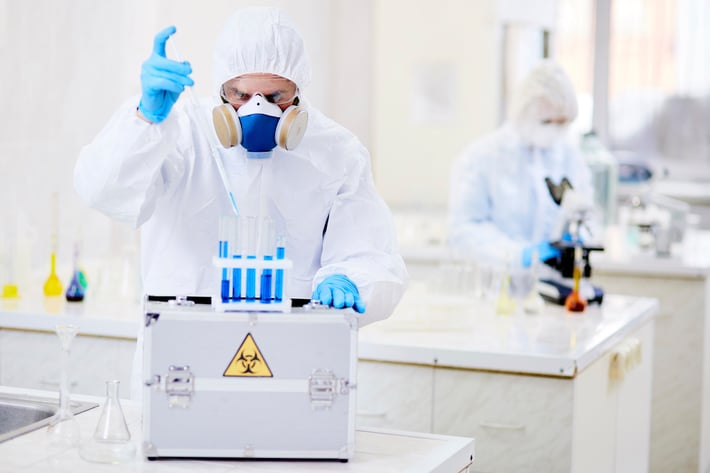
The differences, similarities, and redundancies between building management systems and environmental monitoring systems, and what it means for pharmaceutical, biotech, research, and other life science organizations.
BMS in the Clinical Lab: is it Enough?
What’s the difference between a building management system (BMS, also called a BAS, building automation system) and an environmental monitoring system (EMS)?
To be frank, most facility managers don’t need much more than a BMS to have what’s commonly referred to as a “smart building,” one where basic functions like heat and lighting and security systems are automated.
But most facility managers are not managing biotech buildings, clinical labs, or workspaces where critical scientific work is being executed on finely calibrated equipment, where samples being worked on are often irreplaceable, where a one-degree shift in temperature can ruin years of work. These kinds of environments are so exacting that a BMS alone rarely gets even half the job done.
BMS and Bluetooth: Good Enough for Most... But Most Aren't Doing Pharmaceutical and Life Science Work

BMS technologies and Bluetooth sensors are effective for most types of standard facility monitoring. If your business is in, for example, the manufacture of hard goods, and you’re using warehouses for storage and distribution, you rarely need more than these basic technologies to monitor, secure, and report on your inventory.
In biotech, pharma, and similar areas of practice, these technologies often work well enough for the operational pieces of the business, too: the sales and HR departments, shipping and receiving, etc.
Within the lab space itself, however – the beating heart of these businesses – they simply don’t offer enough functionality to help ensure clean workspaces, quality air flow, proper air pressure, and other environmental factors connected to the scientific accuracy and therapeutic efficacy of the work being done.
For clinical labs and facilities where work is being done on sensitive projects involving irreplaceable resources (such as IVF labs, cryobanks, and blood banks), a BMS’s inability to capture particle counts, air flow, and other specifics is not the only missing piece.
The Best BMS Systems Offer Control, but Labs Need More
When exploring some of the major BMS offerings on the market from companies such as Honeywell, Siemens, and Johnson Controls, we see enterprise-level platforms that can be deployed essentially “out of the box.”
These robust systems offer a complex and (apparently) complete range of features to enable control over a building’s structural systems: HVAC, lighting, and more. The benefits promised by these providers are generally the same, too: lower utility bills, increased efficiencies, predictive maintenance using IoT tools, high-level insight, etc.
The benefits just described are more than enough for an office tower or residential development, but labs and similar facilities need more. Monitoring of a room is not enough: labs often need each piece of equipment precisely monitored. E.g., In a lab you may have both freezers and incubators in the same room, and a BMS simply does not offer the “granularity” in monitoring that these sensitive pieces of equipment require.
Additionally, labs need more granular reporting than a standard BMS provides. There are myriad environmental factors that can derail almost any biotech project, and myriad ways in which these factors may intersect and can have a serious impact as well.
An environmentally sensitive research project can be affected by a door being left open slightly longer than usual, by the intrusion of volatile organic compounds carried by a staffer (in perfume, for example), and by a concurrent lift in temperature and/or air moisture.
A BMS – typically with a single temperature probe in any given room, rather than multiple ones like an EMS – is simply not built to either capture this disparate data, or report on how these numerous factors intersect. Only a lab-specific environmental monitoring system provides the coverage required.

Administration & Implementation of BMS vs. EMS
A major difference between BMS and EMS is tied into who is actually using these systems as well.
For most BMS users, the owner or administrator has more of a building maintenance background and experience in facility systems, perhaps as an electrician, etc. But EMS users are most often people with a scientific background, and the data sets provided by an EMS are a more precise fit for their skill sets and business needs.
Earlier we referred to BMS as often being “out of the box.” Yes, that means cost savings, as there’s little to no customization required, but every life science facility has unique workspaces with specific projects requiring stable environmental conditions and, therefore, extensive customization of any monitoring solution being used. Only an EMS can provide for this level of customization.
Learn more of the differences in our white paper: Environmental Monitoring Systems vs Building Management Systems
BMS and FDA
Finally, a huge differentiator in BMS and EMS – perhaps the biggest – is in FDA readiness.
The FDA standards applied in biotech and pharma are often extensive. Finding a BMS that is FDA-compliant, out of the box, is next to impossible. (In fact, we weren’t able to find a single one… not saying it doesn’t exist, but if so, it’s hard to come by.)
EMS can be built to be readily FDA compliant and kept up to code throughout its lifetime.
Developed within the biotech and pharma spaces, XiltriX’s EMS offerings are built specifically to the FDA requirements being faced by each individual client. In fact, it’s a cornerstone of our service as each EMS we deliver is built to meet the specific needs of each customer, lab, and piece of equipment, and its implementation is informed by both the business goals of the client as well as the FDA (or other regulatory) requirements it has to meet to accomplish those goals.
If you’re already up and running with a BMS, don’t worry. You don’t have to start over. We can often simply extend what you have in place to deliver a full-featured, custom EMS. In any case, we’re here to talk, help explain in more detail the differences (and overlap) of BMS and EMS, and equip you with a solution unique to your lab.
To learn more about how to monitor your facility, read our eBook "Life Science Facility Monitoring":
